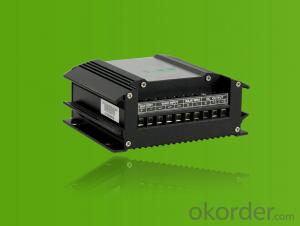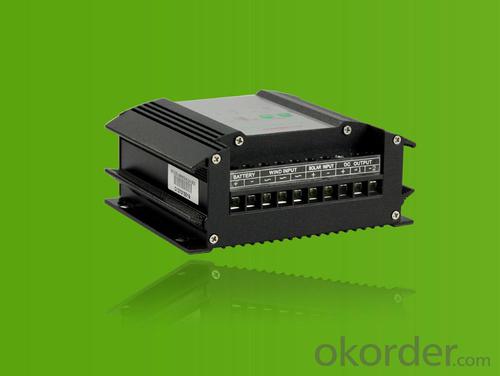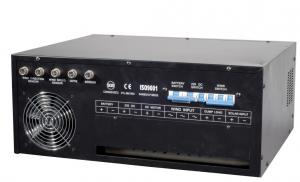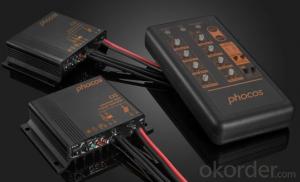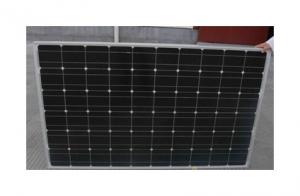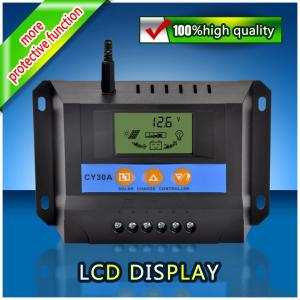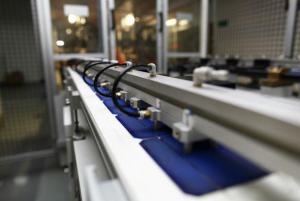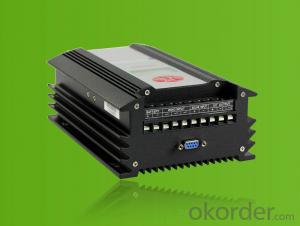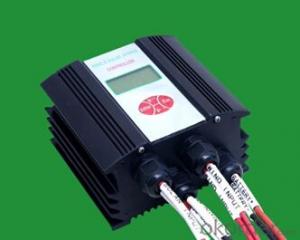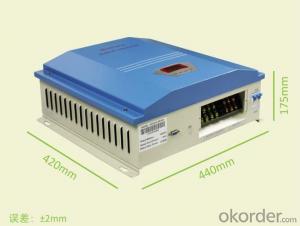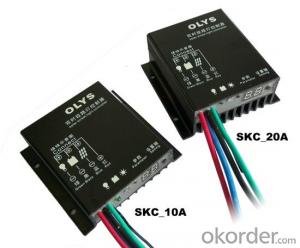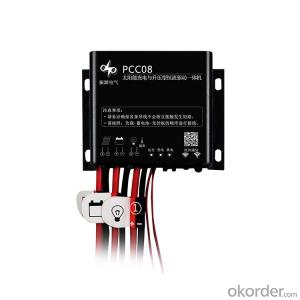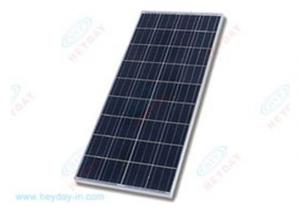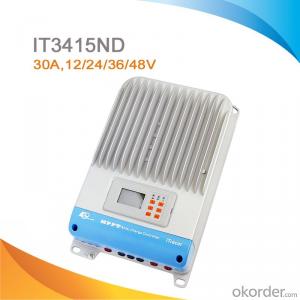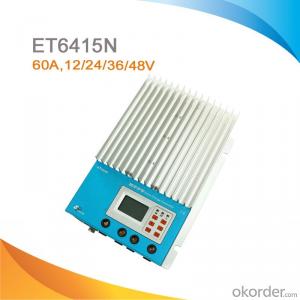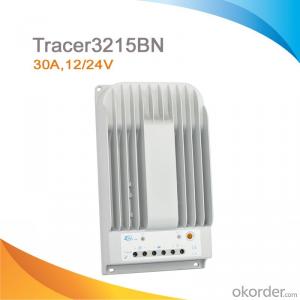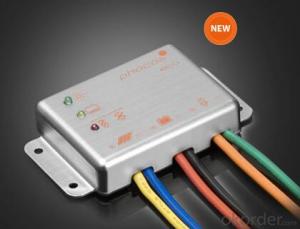Stacking Solar Charge Controllers for Economical Wind Solar Hybrid Street Light Controller
- Loading Port:
- Shanghai
- Payment Terms:
- TT or LC
- Min Order Qty:
- 10 unit
- Supply Capability:
- 10000 unit/month
OKorder Service Pledge
OKorder Financial Service
You Might Also Like
A solar inverter, or PV inverter, or Solar converter, converts the variable direct current (DC) output of a photovoltaic (PV) solar panel into a utility frequency alternating current (AC) that can be fed into a commercial electrical grid or used by a local, off-grid electrical network. It is a critical BOS–component in a photovoltaic system, allowing the use of ordinary AC-powered equipment. Solar inverters have special functions adapted for use with photovoltaic arrays, including maximum power point tracking and anti-islanding protection.
This product has high conversion efficiency, reliable quality, intelligent monitoring system and best service, which will provide you with a memorable user experience and solutions.
I. PRODUCT INTRODUCTION
The wind/solar hybrid street light controller is specially designed for high-end small-scale wind/solar hybrid system and especially suitable for wind/solar hybrid street light system and wind/solar hybrid monitoring system. It can simultaneously control wind turbine and solar panel and transform the wind and solar energy into electricity for the DC load use, with excess energy stored into batteries. Varieties of appearance and function design, which is flexible to meet the requirements of different customers.
II. PERFORMANCE FEATURES
Superior military-grade components to ensure the product stability.
Perfect protection function, thus the system has higher reliability.
LED、digits indicator for freely check and set various of status parameters.
Voltage limiting and current-limiting charge mode ensures battery in the best charging status.
Two DC Load output, light-control, time-control, constant output, and multiple output control mode selection
PWM stepless unload mode, which burn the excess power into Dump load, making the battery charging in best status.
High quality aluminum alloy appearance, with small size and good cooling effect.
III. APPLICATION AREAS
Stand alone wind/solar hybrid power station.
Stand alone domestic household wind/solar hybrid power system.
Mobile Communication base stations, expressway and other non-residential regions.
Coastal islands, remote mountainous, border posts for regions shortage of or without electricity.
Government demonstration projects, landscape lighting project, street light project etc.
IV. 12V TECHNICAL PARAMETERS
Product Model | WWS02-12-B00D | WWS03-12-B00D | WWS04-12-B00D |
Rated battery voltage | 12V | 12V | 12V |
Rated wind turbine input power | 200W | 300W | 400W |
Maximum wind turbine input powr | 300W | 450W | 600W |
Wind turbine brake current | 20A | 30A | 40A |
Rated solar input power | 100W | ||
Wind Turbine Charge Shutoff Voltage | 14.5V | ||
Wind Turbine Charge Recovery Voltage | 13.2V | ||
Battery Under Voltage Shutoff | 10.8V | ||
Battery Under Voltage Recovery | 12V | ||
Input over voltage Shutoff | 16V | ||
PV Voltage Of Light-Control On | 1V | ||
PV Voltage Of Light-Control Off | 1.6V | ||
Load 1 and Load 2 Rated Output Current | 10A | ||
Load 1 Output Mode | Light-Control On and Light-Control Off | ||
Load 2 Output Mode | Light-Control On and Time-Control 5 hours | ||
Dumpload control mode | PWM | ||
Display mode | LED digits indicator | ||
Cooling | Aluminium alloy shell radiating | ||
Protection Level | IP53(Indoor) | ||
Quiescent Current | ≤20 mA | ||
Display Parameters | Over-voltage, Over-discharge, Overload, Short-circuit, Night etc. | ||
Protection Functions | Solar reverse charge protection , Solar reverse connection protection, Battery over charge protection, Battery over discharge protection, Battery reverse connection protection, Over Load protection, Short-circuit protection, Lightning protection, Wind turbine current limiting, Wind turbine automatic brake and manual brake. | ||
Ambient Temperature | -20~+55℃ | ||
Ambient Humidity | 0~93%, without condensing | ||
Working Altitude | ≤4000m | ||
Dimensions (L x W x H) | 125×152×62mm | ||
Net Weight | 0.75kg | ||
In order to serve our customers better, our company can adjust parameters configuration according to customer’s requirement. | |||
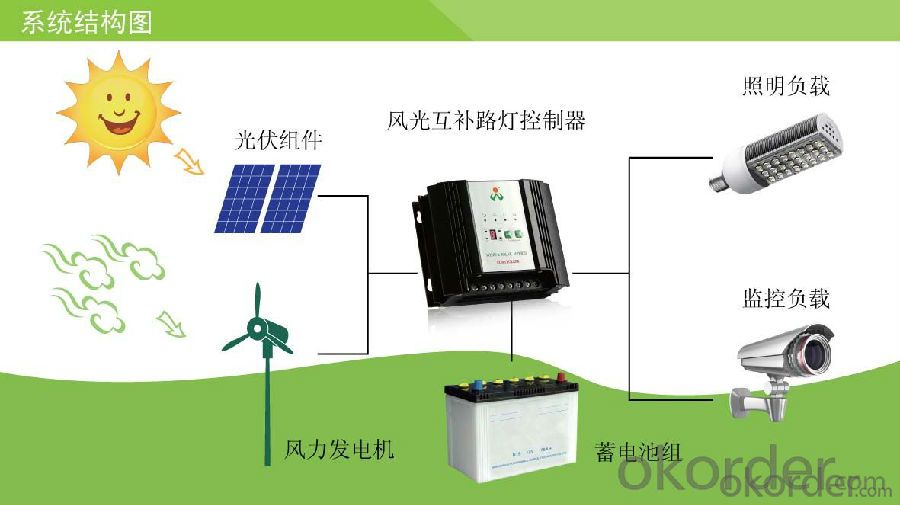
- Q: Can a solar controller be used with a solar-powered mining operation?
- Yes, a solar controller can be used with a solar-powered mining operation. A solar controller is an essential component in managing and regulating the flow of power from the solar panels to the mining equipment. It helps optimize the charging and discharging of batteries, protects against overcharging and over-discharging, and ensures the overall efficiency and performance of the solar power system. Therefore, a solar controller is highly recommended and compatible with a solar-powered mining operation.
- Q: What is the maximum current capacity of a solar controller?
- The maximum current capacity of a solar controller can vary depending on its specifications and model. However, in general, solar controllers are available in a range of current capacities, typically ranging from 10 amps to 60 amps or even higher for larger systems.
- Q: How does a solar controller handle high current flow from the solar panels?
- A solar controller, also known as a charge controller, plays a crucial role in regulating the flow of current from the solar panels to the battery bank. It ensures that the batteries receive the correct amount of charge and prevents overcharging or damage to the batteries. When high current flows from the solar panels, the solar controller manages this by utilizing a few key mechanisms. Firstly, it employs a pulse width modulation (PWM) or maximum power point tracking (MPPT) technique to efficiently convert the high current generated by the solar panels into the appropriate voltage and current required for charging the batteries. In the case of a PWM controller, it rapidly switches the connection between the solar panels and the battery bank on and off, controlling the flow of current and voltage to match the battery's requirements. This method effectively regulates the charging process and prevents excessive current from reaching the batteries. On the other hand, MPPT controllers employ advanced algorithms and circuitry to track the maximum power point of the solar panels, optimizing the energy conversion process. These controllers can handle high current flow by adjusting the voltage and current to maintain the maximum power output from the panels, resulting in more efficient charging of the batteries. Additionally, solar controllers incorporate various safety features to handle high current flow. They typically have built-in protections such as overcharge protection, short-circuit protection, and reverse polarity protection. These safeguards ensure the system remains safe and prevents any damage to the solar panels, batteries, or other connected components. In summary, a solar controller effectively handles high current flow from the solar panels through techniques such as PWM or MPPT, optimizing the energy conversion process. It also incorporates safety features to protect the system and ensure the batteries receive the appropriate charge without any risk of damage.
- Q: Can a solar controller be used with a solar-powered industrial facility?
- Yes, a solar controller can be used with a solar-powered industrial facility. A solar controller is an essential component that regulates and optimizes the charging and discharging of batteries in a solar system. In an industrial facility, it helps manage the flow of energy from the solar panels to power various equipment and machinery, ensuring efficient operation and maximizing the utilization of solar energy.
- Q: What is the input voltage range of a solar controller?
- The input voltage range of a solar controller typically depends on the specific model and its design. However, most solar controllers are designed to operate within a wide range of input voltages, typically between 12V and 48V.
- Q: What is the purpose of a solar controller in a solar power system?
- The purpose of a solar controller in a solar power system is to regulate and optimize the charging of batteries using the energy generated from solar panels. It ensures that the batteries are charged efficiently and prevents overcharging or deep discharging, thus extending their lifespan. Additionally, solar controllers also provide protection against overvoltage, short circuits, and reverse current flow, enhancing the overall safety and performance of the solar power system.
- Q: Can a solar controller handle power fluctuations from the grid?
- No, a solar controller cannot handle power fluctuations from the grid. Its primary function is to regulate and control the power flow from the solar panels to the battery or load. It is not designed to stabilize or manage fluctuations in the grid power supply.
- Q: What is the maximum power consumption of a solar controller itself?
- The maximum power consumption of a solar controller itself refers to the amount of power that the controller consumes in order to perform its functions. The power consumption of a solar controller is generally very low, typically ranging from less than 1 watt to a few watts. Solar controllers are designed to be energy-efficient and minimize power loss. They primarily regulate the flow of electricity from the solar panels to the battery or load, monitor the battery's state of charge, and provide protection against overcharging, over-discharging, and other potential issues. These functions require minimal power consumption. The power consumption of a solar controller can vary depending on factors such as its design, features, and efficiency rating. Generally, more advanced controllers with additional features like LCD displays, data logging, or wireless connectivity might consume slightly more power compared to basic controllers. To determine the specific maximum power consumption of a solar controller, it is best to refer to the manufacturer's specifications or technical documentation. These documents usually provide detailed information on the power consumption and other electrical characteristics of the controller, helping users to make informed decisions and properly size their solar systems.
- Q: How does a solar controller handle over-discharging of the battery?
- The purpose of a solar controller is to avoid excessive battery discharge by utilizing a mechanism known as low-voltage disconnect (LVD). When the battery voltage falls below a certain threshold, typically around 11.5 volts in a 12-volt system, the solar controller disengages the load from the battery. This action prevents the battery from being discharged beyond a safe level, which can significantly diminish its lifespan. Once the load is disconnected, the solar controller continuously monitors the battery voltage. When the battery voltage surpasses a specific level, usually set at around 12.6 volts in a 12-volt system, the solar controller reconnects the load, making the battery usable again. Furthermore, advanced solar controllers may incorporate additional features to safeguard the battery against excessive discharge. For instance, they may possess battery voltage sensing capabilities to accurately measure the battery voltage and activate the LVD at the appropriate threshold. Additionally, they may offer adjustable LVD settings, allowing users to personalize the disconnect and reconnect voltages based on their specific needs. In conclusion, the solar controller plays a crucial role in preventing over-discharge of the battery, guaranteeing its durability and optimal performance in solar power systems.
- Q: Are there any safety concerns with using a solar controller?
- Yes, there can be safety concerns associated with using a solar controller. Some potential safety issues include electrical hazards, such as the risk of electric shock if not installed or used correctly, and fire hazards if the controller malfunctions or overheats. It is important to follow all manufacturer guidelines, use proper wiring and grounding techniques, and regularly inspect and maintain the solar controller to minimize any potential safety risks.
Send your message to us
Stacking Solar Charge Controllers for Economical Wind Solar Hybrid Street Light Controller
- Loading Port:
- Shanghai
- Payment Terms:
- TT or LC
- Min Order Qty:
- 10 unit
- Supply Capability:
- 10000 unit/month
OKorder Service Pledge
OKorder Financial Service
Similar products
Hot products
Hot Searches
Related keywords
